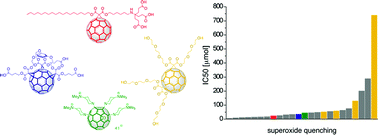Water solubility, antioxidant activity and cytochrome C binding of four families of exohedral adducts of C60 and C70†
Abstract
Over the past decade, surface-modified,

* Corresponding authors
a
The Institut für Organische Chemie, Universität Erlangen-Nürnberg, Henkestrasse 42, Erlangen, Germany
E-mail:
andreas.hirsch@chemie.uni-erlangen.de
b C-Sixty Inc., Houston, USA
c Institut für Physikalische Chemie, Universität Erlangen-Nürnberg, Egerlandstrasse 3, Erlangen, Germany
d Department of Chemistry, University of Cyprus, P. O. Box 20537, Nicosia, Cyprus
Over the past decade, surface-modified,

 Please wait while we load your content...
Something went wrong. Try again?
Please wait while we load your content...
Something went wrong. Try again?
P. Witte, F. Beuerle, U. Hartnagel, R. Lebovitz, A. Savouchkina, S. Sali, D. Guldi, N. Chronakis and A. Hirsch, Org. Biomol. Chem., 2007, 5, 3599 DOI: 10.1039/B711912G
To request permission to reproduce material from this article, please go to the Copyright Clearance Center request page.
If you are an author contributing to an RSC publication, you do not need to request permission provided correct acknowledgement is given.
If you are the author of this article, you do not need to request permission to reproduce figures and diagrams provided correct acknowledgement is given. If you want to reproduce the whole article in a third-party publication (excluding your thesis/dissertation for which permission is not required) please go to the Copyright Clearance Center request page.
Read more about how to correctly acknowledge RSC content.
 Fetching data from CrossRef.
Fetching data from CrossRef.
This may take some time to load.
Loading related content
